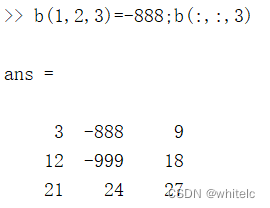

If you time fewer iterations of larger arrays, > The message seems to be that you should never use circshift!įYI, circshift is doing some error checking and your other codes do not.Īlso, you are timing lots of small (length 100) circshifts so the errorĬhecking counts a lot.
#Circshift matlab non integer Pc
> On my Linux PC this startup time is about 0.2ms.
#Circshift matlab non integer code
> For circshift the CPU time hardly depends on the array size, indicating a significant startup overhead as the Matlab code does some checks on the array.

> For 2D arrays the effect is still there, though less extreme. > I have not tried shifts by more than 1 place though I expect it would be similar. > For larger arrays the colon notation is the fastest method. n must be a vector of integers no longer than the number of dimensions in x.

shiftsize is a vector of integer scalars where the n -th. Even using Matlab's colon notation directly is slower than a loop. : y circshift (x, n): y circshift (x, n, dim) Circularly shift the values of the array x. B circshift(A,shiftsize) circularly shifts the values in the array, A, by shiftsize elements. > Amazingly it seems that for a 1D array of size 100, Matlab's circshift is 50 times slower than simply using a loop. > repeatedly on a modestly sized 1D array. > I recently came across this fact in a different application, in which I need to do circshifts However, a non-integer shift value can be used, in which case the. The rem function follows the convention that rem (a,0) is NaN. This function is often called the remainder operation, which can be expressed as r a - b.fix (a./b). > Matias Nordin pointed on a recent thread that circshift can be very slow. FSHIFT shifts the elements in a vector by a given number of elements, as CIRCSHIFT does. r rem (a,b) returns the remainder after division of a by b, where a is the dividend and b is the divisor. % CHECK SPEED OF CIRCSHIFT VS OTHER METHODS. In contrast to other approaches to non-integer shifts of matrices on the base of fft2 or interp2, the number of dimensions of A is not limited, and the syntax. The message seems to be that you should never use circshift! On my Linux PC this startup time is about 0.2ms. So when it comes time to do celldisp(), there is no out at all to display. I have not tried shifts by more than 1 place though I expect it would be similar.įor 2D arrays the effect is still there, though less extreme.įor circshift the CPU time hardly depends on the array size, indicating a significant startup overhead as the Matlab code does some checks on the array. E doesnt have a 20th dimension so size(E,20)-1 0-1 -1 which means your loop never gets entered. Even using Matlab's colon notation directly is slower than a loop.įor larger arrays the colon notation is the fastest method. shift the elements of a vector by non-integer shift in matlab Ask Question Asked 9 years, 6 months ago Modified 16 days ago Viewed 2k times 2 I want to shift a vector by non-integer shift, linear interpolation seems to be not very accurate so I'm trying to use sinc interpolation by the following code which uses Fourier transform. So I did some tests, see code below.Īmazingly it seems that for a 1D array of size 100, Matlab's circshift is 50 times slower than simply using a loop. posinfo is a 437圆 double matrix m is a 400x400x3 boolean matrix posinfo(indvalues,4) floor(xshift) posin. non linear mpc in matlab I have a speed profile of a vehicle which consist. I recently came across this fact in a different application, in which I need to do circshifts Learn more about circshift, type, vector MATLAB I'm using circshift to move a mask, but I'm running into a problem. Shift an Array Using the circshift () Function in MATLAB If you want to shift. Recently I needed this function to replicate Matlab’s circshift, which can do it for 2D arrays.Matias Nordin pointed on a recent thread that circshift can be very slow. Show -1 older comments Hide -1 older comments. The array a is a 3-by-3 array we can add a third dimension to a, by providing the values like. a 7 9 5 6 1 9 4 3 2 MATLAB will execute the above statement and return the following result. If the input is signed, bitsra shifts the most significant bit. If the input is unsigned, bitsra shifts zeros into the positions of bits that it shifts right. For floating-point operations, it performs a multiply by 2-k. Note: The contents have been superceded by a better version at : įor a better circshift using std::rotate check out For example, lets create a two-dimensional array a. cbitsra (a,k) returns the result of an arithmetic right shift by k bits on input a for fixed-point operations.


 0 kommentar(er)
0 kommentar(er)
